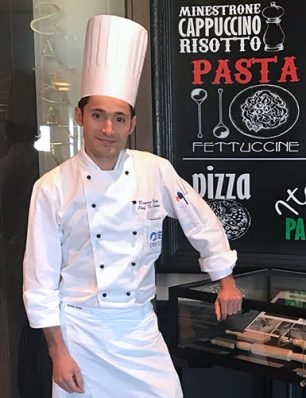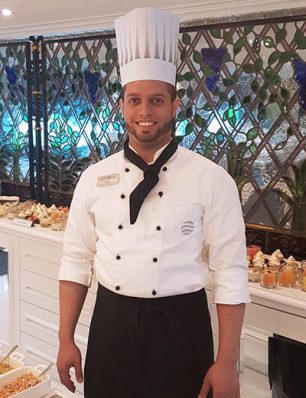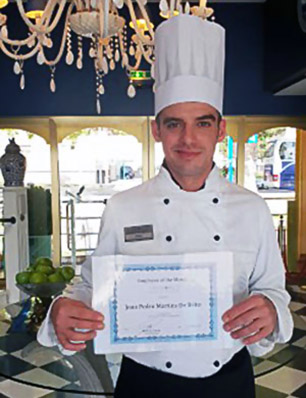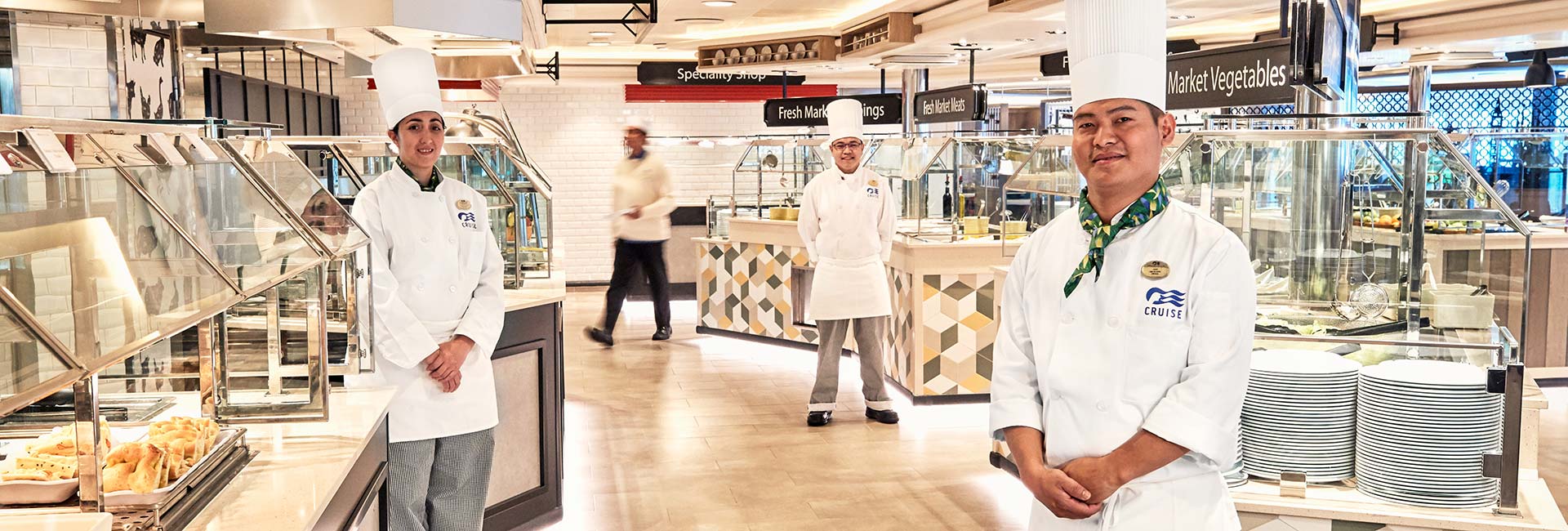
Cruise Ship Culinary Jobs
Cruise ship jobs for kitchen staff: Chef de Cuisine, Sous Chef, Pastry Chef and Commis Chef
The Galley on cruise ships is the term used to describe the kitchen. In most ships’ Galleys, the team of kitchen staff is similar to the Escoffier model on land, where you will find an Executive Chef and several Chefs de Cuisine at the top of the Galley organization. Below the Executive Chef and the Chefs de Cuisine, you will find a team of Sous Chefs, Chefs de Partie, Pastry Chefs, Demi Chefs de Partie and an army of utility cleaners.
INFORMATION ABOUT CRUISE SHIP GALLEY JOBS
Are cruise line culinary jobs similar to restaurant jobs?
There are many similarities between culinary jobs in restaurants and cruise line kitchen jobs, but there are also considerable differences. One significant difference is the size of the cruise ship Galley / kitchen. The second one is the volume of food being prepared.
The size of the Galley on cruise ships can vary from 10 cooks on small river cruise lines to up to 300 cooks on large ocean cruise lines. And so, when 300 Chefs work together on a ship, it is expected that they are cooking extremely large amounts of food.
Here are a few examples of the volume of foods being cooked / processed on a 7-day cruise on a large ocean cruise ship with a total population of 6000 passengers and crew:
- 20 000 eggs
- 800 gallons of ice cream
- 1000 pounds of lobster
- 5000 pounds of flour
- 7000 baked potatoes
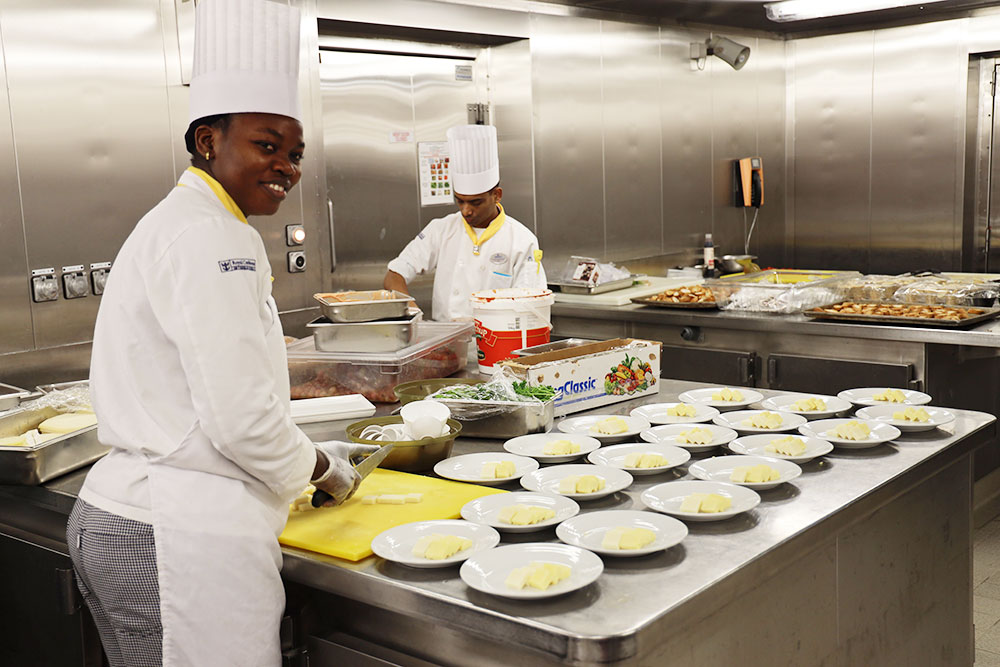
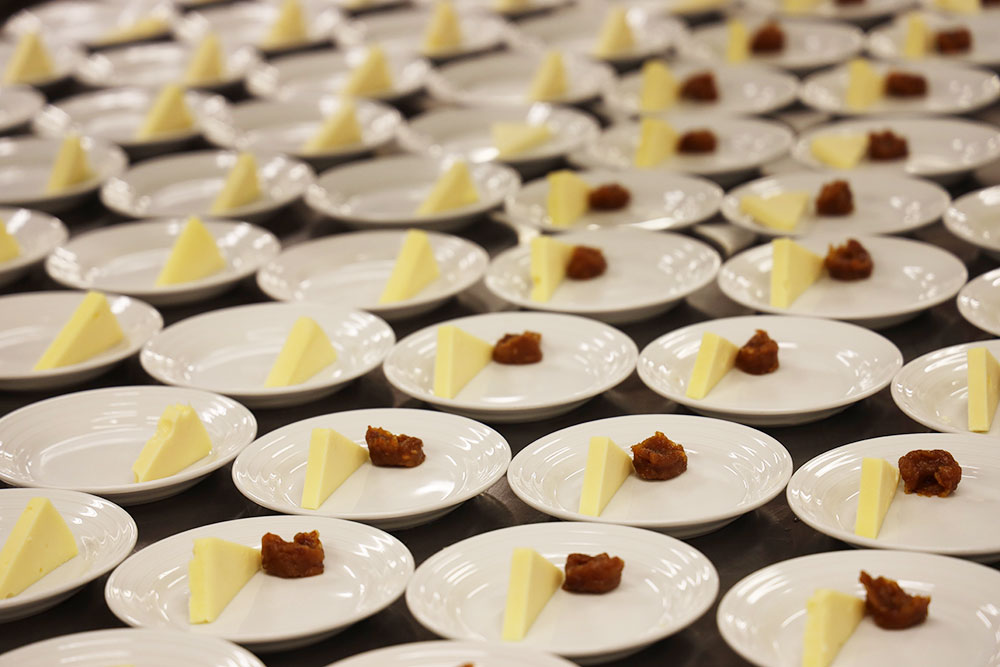
How is the kitchen organized?
On large vessels, there is usually a central (or main) Galley near the main dining room. This central Galley is the heart of the kitchen operation. It is where the majority of the foods being served on the cruise ship will be prepared from scratch, and where you will find dedicated culinary sections such as meat, fish, sauces, garde manger, entremetier, pastry, bakery, etc.
In addition to the central Galley, there are other kitchens for smaller outlets, where you will find autonomous brigades of kitchen staff in charge of specialty restaurants or specific food outlets. On large passenger vessels, you can find up to 11 restaurants (specialty restaurants).
In addition to the main Galley and specialty restaurants, there are other food outlets such as patisseries and ice cream parlors located throughout the cruise ship.
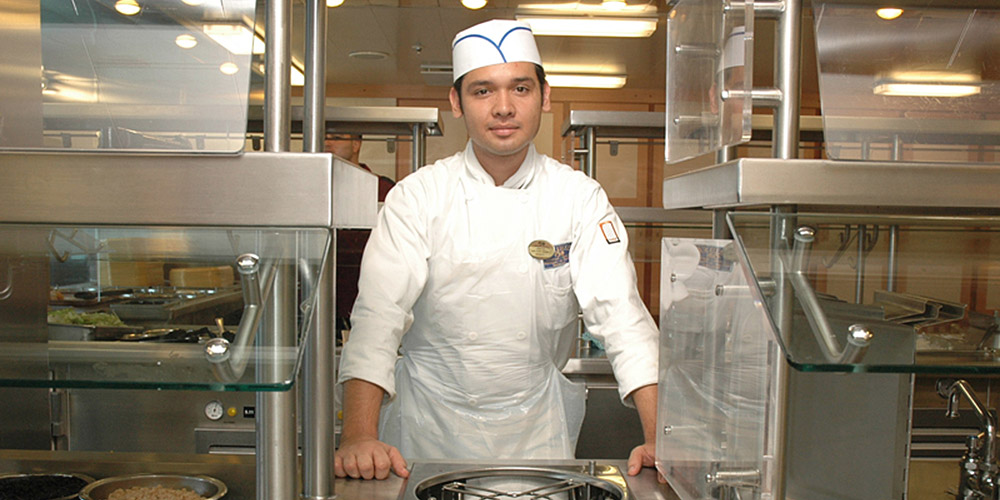
How do cruise line Chefs adjust to working with high volume of food?
The volume of food being prepared in the cruise line Galley is definitely an adjustment for many culinary professionals who have never worked on cruise ships before. It is important to keep in mind that, whilst the food being prepared is on an XXL scale (up to 12000 plated meals per day on large ships), the focus placed on quality and presentation of food is as important as if working in a fine-dining restaurant on land. For this reason, many cruise lines employ culinary professionals with experience working in land-based restaurants awarded with industry recognitions such as Michelin stars, Rosettes, etc. And for many of these Chefs coming from such prestigious land-based establishments, the transition from small structures on land to mega kitchens found on cruise line ships can be challenging. A top cruise ship Pastry Chef is expected to produce cakes as beautiful as the ones s/he would produce in a small upscale restaurant on land. The difficulty kicks in when s/he realizes that each sugar rose being sculpted by his/her talented hands has to look as beautiful and perfect on the first cake being produced as on the 100th cake being produced for the daily consumption of the cruise line passengers.
In order to make this complex and gigantic kitchen operation work smoothly, a military like structure is required with every cruise ship Chef being given a specific job task and clear directives. The bigger the cruise ship, the more specific the job tasks being assigned to each cook. Please note that on smaller river ships, it is expected that cooks will cover several sections of the Galley, and so a cruise ship Sous Chef may have to learn to be skilled in more than one section right from the start of his/her contract. Every aspect of the food production, from food ordering, food stockage, etc. has to be carefully planned with a great deal of focus on cost control, portion control, waste management, and most importantly a very high focus on health and hygiene.
Hygiene on cruise ships Galleys: a top priority
Hygiene on cruise ships is a top priority for all members of the kitchen staff.
Whilst it is expected that a restaurant kitchen on land will be clean at all times, on ocean and river cruise lines “clean” is not the norm – “immaculate” is the norm.
On cruise ships, the Galley is regularly inspected by the representatives from governmental bodies from the countries the ships visit. A cruise line can be penalized, if very strict standards of health and hygiene are not met during these unannounced inspections. For instance, all ships calling into the United States will be inspected on a regular basis by the representatives from the United States Public Health (USPH) entity. At the end of each inspection, USPH Officers will issue a score. These scores are not only published within the cruise line industry, but can also result in heavy monetary fines for the cruise line. The cruise ships may even be banned from entering the US, if the scores are considered too low. For these reasons, it is important to understand that all staff members of the Galley (at all levels) dedicate an enormous amount of time to make sure that all food outlets exceed the standards of hygiene established by the cruise line owners and the governmental bodies that inspect the facilities.
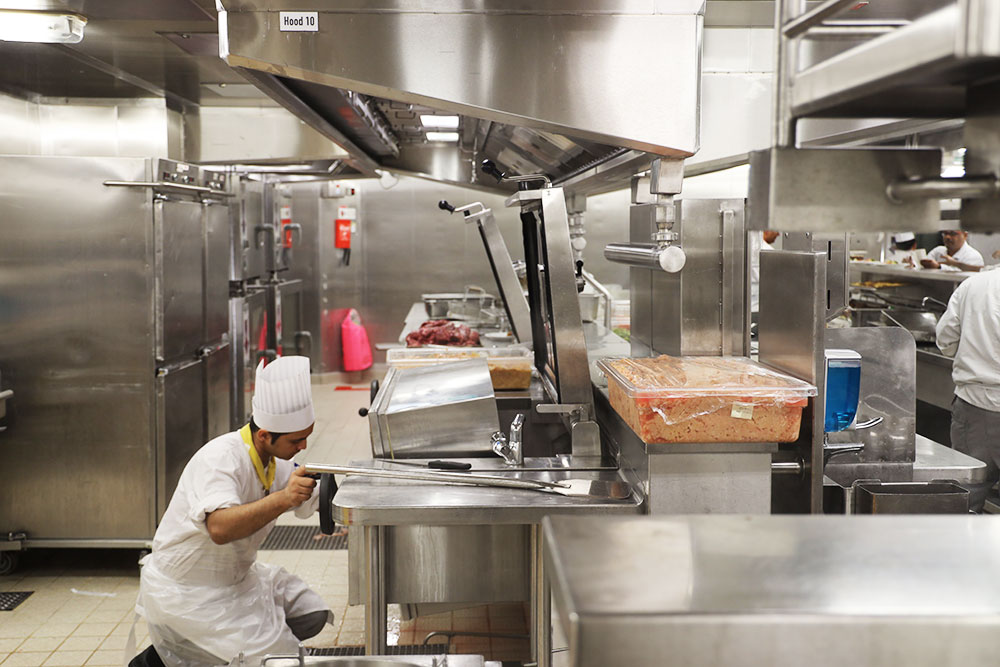
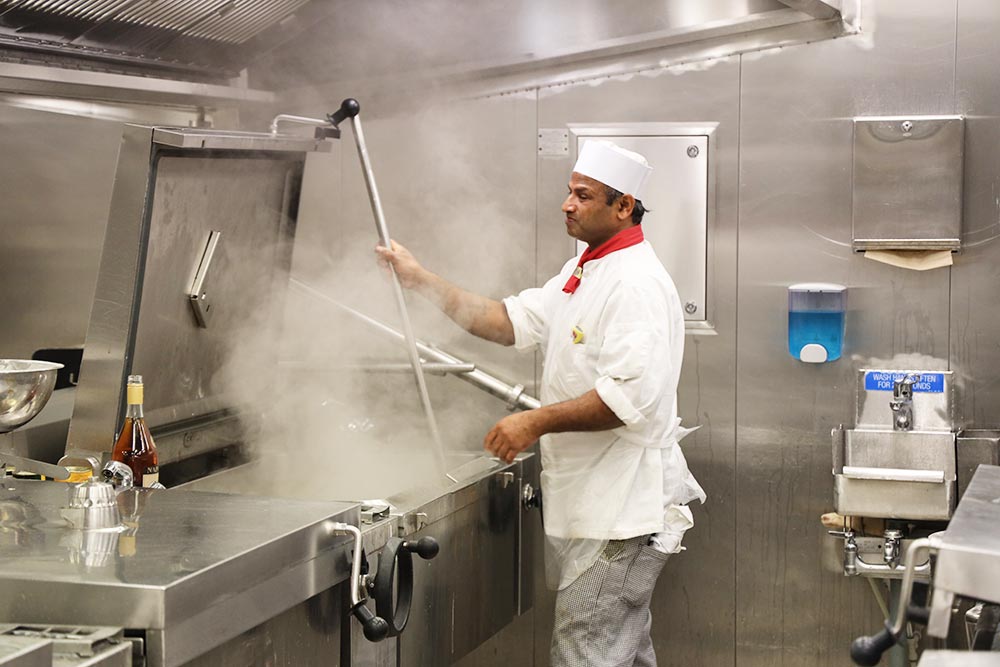
Communication skills when working as a Chef on a cruise ship
Another job aspect, that may be different for culinary professionals that start working on cruise ships for the first time, is collaborating with other Chefs of various national and cultural origins. There may be up to 20 different nationalities working in the kitchens on cruise ships. Whilst English is the official language, is it sometimes a bit challenging to adjust to such a culturally diverse environment, and the myriad of accents for a Cook who has never worked outside of his/her home country.
Making the decision to work as a Cook on a cruise ship
It is important to note that cruise line culinary jobs are very rewarding but also very challenging. Working 7 days a week contracts, that can last 4, 5 or 6 months, is a very difficult adjustment to make. Also, if there is one area on the cruise ship where the hours are exceptionally long, it is definitely the kitchen. Producing 12000 plated meals per day on large ships, where food is available to passengers 24-hours a day, means that the hours will be long for all kitchen staff members.
On small river ships, the spectrum of food choices available to passengers may be on a smaller scale, but the kitchen team is also considerably smaller. For this reason, all cruise cooks must be willing to perform different Galley jobs and different kitchen job tasks. They should also expect to work long hours.
The decision to work as a Chef in the Galley on a cruise ship must be taken based on the understanding that the work will be hard, the hours will be long, and the standards will be very high. The work environment will be very intimidating at first, but there will be many rewards that come with the job as well. One of these rewards is the fact that the cruise line industry offers fantastic career opportunities. The Chefs who apply themselves and show dedication and commitment to their work, can expect promotions to higher levels within the cruise line kitchen staff organization structure.
Which candidates are we recruiting for the cruise ship culinary jobs?
The profiles the cruise lines look for will depend on the cruise ship Galley job you are applying for. The cruise lines usually like to see candidates with kitchen job experience with relatively large structures such as hotels, resorts, other cruise lines.
The hiring cruise lines also look for candidates with experience with international cuisine. Someone who has only cooked local cuisine in his/her country will be facing a steeper learning curve working on board a cruise ship. One of the questions asked during interviews with the cruise lines has to do with the “mother sauces”. If a job candidate understands the difference between a béchamel and a hollandaise, then it is likely that s/he will be able to prepare sauces derived from these two classical mother sauces. Therefore, a good knowledge of the classical culinary recipes is always important for all culinary jobs’ candidates. Experience with French cuisine is also a plus.
The cruise lines also favour job candidates who have worked in restaurants with international recognitions such as Michelin stars, Rosettes, etc. Another important factor is employment longevity in the establishments where the candidate has worked. A Chef who moves too rapidly from restaurant to restaurant, or even from cruise line to cruise line, is likely to continue to move, once employed by a new cruise line. It is important to “stick” to an employer for relatively long periods of time and, ideally, show professional growth within one culinary establishment. This is a very positive sign for the cruise lines that the candidate was willing to apply his/her skills long enough to be noticed by his/her employer.
And last, but not least, a good level of English is required by the hiring cruise lines. Whilst, most cruise line Galley cook jobs do not involve a great deal of interaction with passengers, it is important to understand that English is the official language in Galleys. This is the case for all the cruise line companies which Pro Sea Staff represents, and so all members of the Galley staff will be expected to communicate in English.
Basic English will be acceptable for entry level positions such as demi Chefs de Partie. However, the higher the rank within the cruise ship Galley structure, the higher the level of English expected from job applicants. A Chef de Cuisine is expected to speak fluent English to be able to communicate clearly with his/her subordinates and superiors, produce reports, inventories, etc.
Cruise ship kitchen job profiles
If you are looking for cruise line culinary job opportunities, check our list of current vacancies on cruise ships!
